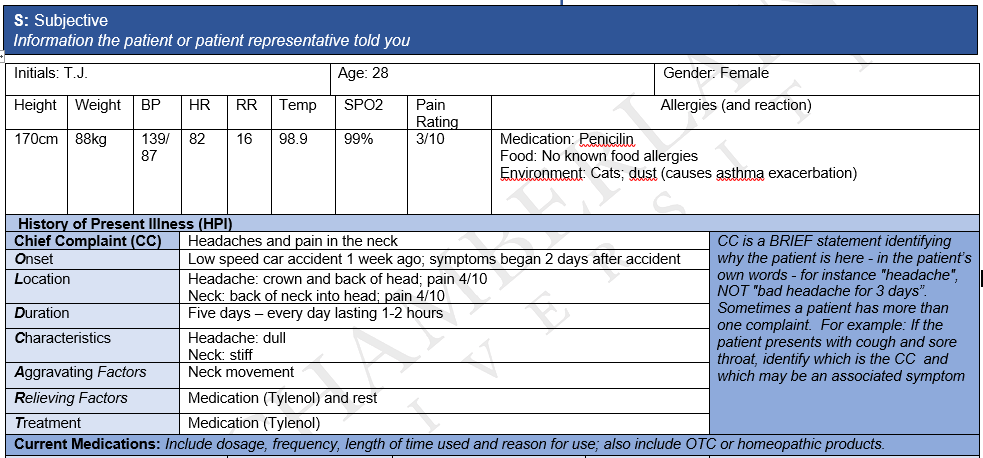Requirements
NOTE: Before initiating any activity in Shadow Health, complete the required course weekly readings and lessons as well as review the introduction and pre-brief.
- Complete the Shadow Health Concept Lab (Weeks 2, 4, and 5) prior to beginning the graded assignment.
- Gather subjective and objective data by completing a focused, detailed health history and physical examination for each physical assessment assignment.
- Critically appraise the findings as normal or abnormal.
- Complete the post activity assessment questions for each assignment .
- Complete all reflection questions following each physical assessment assignment.
- Digital Clinical Experience (DCE) scores do not round up. For example, a DCE score of 92.99 is a 92, not a 93.
- You have a maximum of two (2) attempts per Shadow Health assignment to improve your performance. However, you may elect not to repeat any assignment. NOTE: If you repeat an attempt, ONLY the second attempt will be graded, regardless of the DCE score. Please refer to the grading rubric categories for details.
- Download the Lab Pass for the final attempt on the assignment.
On the Canvas Platform:
- Summarize, organize, and appropriately document findings using correct professional terminology on the SOAP Note Template.
- Identify three (3) differential diagnoses and provide ICD-10 codes and pertinent positive and negative findings for each diagnosis.
- Create a comprehensive treatment plan for each assignment. Must address the following components: Diagnostics, Medication, Education, Referral/Consultation, and Follow-up planning. If no interventions for one or more component, document “none at this time” but do not skip over the component.
- Provide rationales and citations for diagnoses and interventions.
- Include at least one scholarly source to support diagnoses and treatment interventions with rationales and references on the SOAP note. Only scholarly sources are acceptable for citation and reference in this course. These include peer-reviewed publications, government reports, or sources written by a professional or scholar in the field. The textbooks and lessons are NOT considered to be outside scholarly sources. For the threaded discussions and reflection posts, reputable internet sources such as websites by government agencies (URL ends in .gov) and respected organizations (often ends in .org) can be counted as scholarly sources. The best outside scholarly source to use is a peer-reviewed nursing journal. You are encouraged to use the Chamberlain library and search one of the available databases for a peer-reviewed journal article. The following sources should not be used: Wikipedia, Wikis, or blogs. These websites are not considered scholarly as anyone can add to these. Please be aware that .com websites can vary in scholarship and quality. For example, the American Heart Association is a .com site with scholarship and quality. Each student is responsible for determining the scholarship and quality of any .com site. Ask your instructor before using any site if you are unsure. Points will be deducted from the rubric if the site does not demonstrate scholarship or quality. Current outside scholarly sources must be published with the last 5 years. Instructor permission must be obtained BEFORE the assignment is due if using a source that is older than 5 years.
- Upload the Lab Pass to the appropriate assignment area in Canvas Grades
Shadow Health Grading Rubric
Portions of the rubric are designated with a ***. The following explains those portions of the rubric:
* Digital Clinical Experience (DCE) Score is automatically translated by Shadow Health based on individual student performance and reflects how student work compares to their peer learners across the country for a particular assignment. The DCE Score is a fair assessment of effort, and therefore is appropriate for use when grading assignments.
**Scholarly Sources: Only scholarly sources are acceptable for citation and reference in this course. These include peer-reviewed publications, government reports, or sources written by a professional or scholar in the field. The textbooks and lessons are NOT considered to be outside scholarly sources. For the threaded discussions and reflection posts, reputable internet sources such as websites by government agencies (URL ends in .gov) and respected organizations (often ends in .org) can be counted as scholarly sources. The best outside scholarly source to use is a peer-reviewed nursing journal. You are encouraged to use the Chamberlain library and search one of the available databases for a peer-reviewed journal article. The following sources should not be used: Wikipedia, Wikis, or blogs. These websites are not considered scholarly as anyone can add to these. Please be aware that .com websites can vary in scholarship and quality. For example, the American Heart Association is a .com site with scholarship and quality. Each student is responsible for determining the scholarship and quality of any .com site. Ask your instructor before using any site if you are unsure. Points will be deducted from the rubric if the site does not demonstrate scholarship or quality. Current outside scholarly sources must be published with the last 5 years. Instructor permission must be obtained BEFORE the assignment is due if using a source that is older than 5 years.
***Components of a treatment plan include diagnostics, medication, education, consultation/referral, and follow-up planning
****Insight refers to the capacity to gain an accurate and deep intuitive understanding of a concept or thing. For example, one might demonstrate insight by relating a concept to a personal or meaningful experience.
You can always check out (Solution) NR509 Week 4: Shadow Health Assessment Assignment
Solution

Kindly click the purchase icon to purchase the full solution at $10

